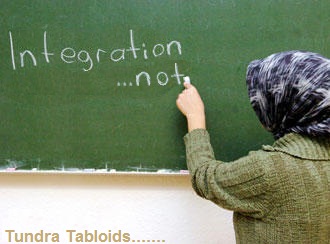YLE, state propaganda 1st, 2nd and 3rd, and always on the public dime.
Finland regularly measures high on the international scale for scholastic achievement, that achievement however will be short lived once the impact of having to deal with immigrants on a massive scale and with all the problems that it entails.

Many teachers wrote that they see the cultural differences as more of a blessing than a curse. They say that immigrant families should be better distributed throughout Finland specifically so they can enrich Finnish life with their presence in as many places as possible. One teacher respondent said it best:
“Diversity is good for all children – both the immigrants and the Finns.”
Lunatics…….
Finland’s teachers: Concentrating immigrants in the same areas creates problems
A recent survey of Finland’s teachers shows that the clear majority feel that creating foreign-language enclaves in Finnish society is problematic, mostly because it discourages immigrant-background children from learning fluent Finnish.

Schools are traditionally one of the most important venues for the integration of newcomers. Teachers with experience in instructing immigrant-background children in Finland say policies allowing immigrants to concentrate in certain areas are a bad idea.
According to a recent survey conducted by the national broadcaster Yle and the teachers’ union OAJ, teachers in Finnish schools with a foreign-language population of more than ten percent feel children’s immigration suffers if they do not have enough interaction with Finnish-speaking children and adults. For purposes of the study, foreign-language students included those whose mother tongue is something other than Finnish, Swedish or a Sami language.
Of the 455 experienced teachers that responded to the survey, just over 42 percent agreed with the statement: ”It is a problem if immigrants concentrate in certain areas and at certain schools”, while close to 44 percent somewhat agreed. In other words, 86 percent were in some sort of agreement, with fewer than 8 percent professing some degree of disagreement and just over 6 percent answering that they can’t say.
A total of 270 Finnish schools in which immigrants make up more than ten percent of the student body participated in the study. Of the teachers that responded to the survey, 38 percent have taught immigrant children for over 10 years, 26 percent between 5 and 10 years and over 26 percent between 2 and 5 years.
Finnish is best learnt with Finns
The primary reason teachers oppose the formation of immigrant enclaves in Finnish society is a linguistic one. Teachers have noted that the Finnish language skills of their pupils remains inadequate in neighbourhoods and schools that are too immigrant-heavy.
The teachers justify their stand with proof: if many students that speak the same language are in the same school, they speak their native language when they are together and don’t learn Finnish well enough.
If children find it difficult to study in the Finnish language, teachers relate that they sometimes forced to simplify the content of their teaching, leaving gaps.
One-third maximum
Many of the teacher survey respondents expressed the desire that no more than one-third of their students would speak a foreign language. This, they say, would best facilitate optimal Finnish language retention among them.
At present, Finland has about fifty schools where the number of foreign-language students exceeds this one-third quota.
The teachers report that foreign-language students increase their work load in many ways.
“Settling disputes between the students requires more time, due to the lack of language skills,” one teacher says. “Working together with the parents who don’t speak Finnish is also time-consuming.”
Another related phenomenon is that if a school gathers a large amount of foreign-language students, the Finnish language parents in the neighbourhood may choose to send their children to a different school. Researchers and teachers have both noted this trend.
“Finnish parents start to avoid the school, even if it is the nearest one to where they live. There really is no reason for this,” replies a survey respondent.
Language skills determine school success
Teachers agree that diverse and rich language skills in one of the country’s principle languages are the cornerstone of integration. Over 53 percent say that language comprehension difficulties are the primary reason for potential immigrant pupil problems.
The most challenging situations are foreign-language children who enter the Finnish education system at the secondary level.
“Studies at grades 8 and 9 at the upper comprehensive school levels require an understanding of large-scale, abstract entities. This is not possible without sufficient language competence. Language is our primary thinking tool,” says one teacher.
But, just as with children the world over, a stable home environment and parental support have a huge effect on school success. If an immigrant-background student’s parents speak Finnish and help with homework, he or she will do better.
The responding teachers say that many children that have only moved to the country recently already speak Finnish as well as native speakers. These same pupils also win top grades.
“Some do better than the Finns, even though they have only come to the country a few years ago,” said one teacher.
Culture clashes a regular occurrence
Cultural differences are a recurring problem in schools with a strong immigrant population.
According to the survey, ten percent of teachers run into cultural and religious issues on a daily basis, while just under one-fifth of the respondents say it is a weekly event. Nevertheless, close to 47 percent say they occur less than once a month.
Examples include the arrangement of physical education classes, where some of the girls must shower separately. Some teachers say that a few immigrant boys have problems obeying their female teachers.
“Cultural differences between the Muslim and Christian religions pose challenges, but so do the Jehovah’s Witnesses and others, for that matter,” said one teacher.
